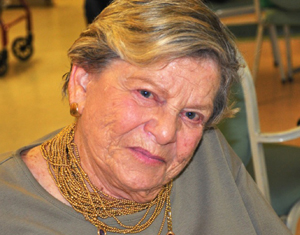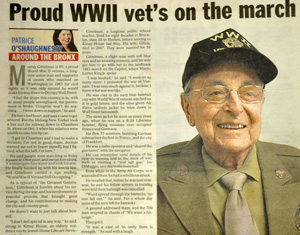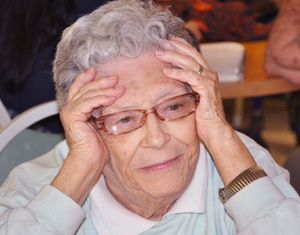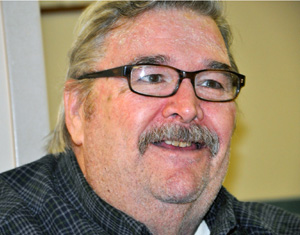Bronx Seniors Share Secrets to a Good Life
By The Bronx Journal Staff
“We have done horrible things with aging. Our country has not helped people to understand what it really means to age positively.” — Dr. Laura Singer
Residents of Kittay House, an independent living center in the Bronx, set remarkable examples of how to live well, age gracefully and never stop learning.
On a recent visit, we spoke with a dozen residents, aged 64 to 95, all with tales to tell. Many were pioneers in their fields — advertising, psychotherapy — while others fought in World War II and still live by lessons learned during the Great Depression.
There were many CUNY graduates and world travelers. All still keep active. Here are their stories.
 Edna Nelkin
Edna Nelkin
“The spoon that stirs the pot makes things happen.”
In a room filled with people, Edna Nelkin stands out, wearing an 18-karat Italian gold chain laden with stones such as sapphires and rubies. Nelkin, 91, is a mother, a wife and an accomplished artist known for her jewelry creations. She was also one of the first women to work as a diamond broker.
“Very few women were stock brokers,” she says, explaining how she first started working with stones. “I learned the business and became a broker for diamonds. I remember when I made $200 on my first sale. I remember other women being surprised to see a woman broker. I would have $4 in my pocket book, while I carried over $200,000 in diamonds.”
Nelkin was born in Brooklyn to Russian parents. When she was 18, she realized that she wanted to explore the world. “I was ready to learn,” she says.
During World War II, Nelkin volunteered as a hostess for the United Service Organization (USO), entertaining servicemen.
In 1946, she opened her own jewelry store in Brooklyn, with help from her father. Despite segregation laws at that time, Nelkin was one of the first to hire African Americans at her store. In 1976, she closed her business and began to travel with her husband. “We went to China and went to Africa the next day. I spent some time in Mexico, in the mountains of San Miguel,” she says.
“I wanted to taste the world,” she says. “I cooked that way. I lived that way. It’s been like that my whole life.”
Over the past two decades, Nelkin has written five books, including volumes of poetry, such as Reflections, published in 2005. “Someone once told me ‘Whatever you do, never stop writing’,” she says.
Nelkin was one of the founders of Writers in the Mountains in upstate New York. She also created, wrote and edited the weekly newspaper Chit Chat in Killington, Vermont.
“I was always a rebel and wanted to do things,” she says. “Take risks. You don’t always have to be covered. Always take a step out of the box. The spoon that stirs the pot makes things happen.”
— Kinvelyn Guaba
 Dr. Laura Singer
Dr. Laura Singer
“People are still growing at our age.”
Tough, fashionable and with a bright spirit, 95-year-old Dr. Laura Singer likes to live in the now, not in the past.
Singer is a psychoanalytic psychotherapist and says living a long life is a wonderful gift, something she is not going to take for granted. She spends this gift of “extra time” trying to help others grow and develop.
Singer has an office in Manhattan and receives a small number of patients every Friday.
She holds two sessions at Kittay House to help residents connect with one another. “People are still growing at our age,” she says. “Age is not a limit, but a blessing,” she adds.
Singer grew up in the Bronx. At age 20, she moved to Manhattan. Her first job was as a nursery school teacher. She has written several books on sex therapy, marriage counseling and sex education.
She herself married three times. “I had three husbands and I loved two of them dearly,” she says.
In the late 1970s, Singer had a show on a local station called “Living Together,” in which she and another therapist helped couples address their marital issues. She also created a hotline where people could call to talk about their marital distress. S.A.M. (Save a Marriage, Inc.), as it was called, was the first hotline of its kind in the United States, she says.
— Hector Felix
 Betty Ruth Caplan
Betty Ruth Caplan
“You can make your own future.”
“The thing about journalism is that it can lead you anywhere,” says Betty Ruth Caplan, 83, a former reporter. Caplan spent her career writing newspaper and magazine articles, scripts for shows, and lyrics for songs.
Caplan’s mother died when she was 10, following her sister’s death at 16. The only sibling she has left, her older brother, lives in another group home. They visit each other a much as possible, via Access-a-Ride.
When Caplan was 11, she started writing a circular for her family about what went on each week. “When I was a child, I didn’t know what an interesting life I lived, because I was a child,” Caplan says.
A native of the Bronx, Caplan says that she misses her days of running around the Pittsburgh neighborhood where she grew up. After traveling the world as a journalist, she now spends a lot of her time writing about the history of her family and the activities at Kittay House.
Caplan is a mother to three boys: Andrew, 57, Martin, 55, and Edward, 52. She has a daughter named Nancy, whom she said would kill her if she told people her age. She has six grandchildren. Two live in Iowa with Edward, two in San Francisco with Martin, and the remaining two are here in New York.
Caplan has words of advice for aspiring journalists. “Just remember, you can make your own future,” she says. “Anything that captures your attention, write about it.”
— Fatima Sesay
 Maurice Gittelman
Maurice Gittelman
During his freshman year in Brooklyn College, 91-year-old Maurice “Murray” Gittelman was among the first engineering students to be drafted in World War II for a national radar network to catch an enemy attack from the coastal lines.
After the project failed to come to fruition, he was then employed at a signal corps in Philadelphia to write encryptions for the stations in the Arctic Poles. However, he joined the services later because of immense peer pressure.
After joining, Gittelman was tested and sent into the Air Force, although he was absolutely terrified of heights. He said that heights were the least of his problems. “I was okay until I started getting plane sickness,” he said chuckling.
Years after his service, Gittelman showed a great sense of responsibility by advocating for human rights. He has been an activist as far back as the Civil Rights movement and as recently as Occupy Wall Street.
One might wonder how someone his age can have robust health, as well as a firm hand shake. He has been active, staying in shape since he was 55 and was diagnosed with a heart condition. Gittelman gladly accepts compliments from many who would have not thought that someone his age can keep up with his daily jogs.
— Delbert Brown
 Ruth Kaplan
Ruth Kaplan
“We are all looking for a community.”
Young people struggling to pay for college might say that 89-year-old Ruth Kaplan’s education was a breeze.
When she attended Brooklyn College in the 1940s, the library and lab fees were $25 each, and tuition was free.
The rules were different then. You had to have a B- or a B+ grade point average to be able to take classes during the day. Those that didn’t make the GPA went to school during the night, Kaplan says. She attended school during the day.
Kaplan’s candid light-blue eyes smile as she speaks.
Even though she is a US citizen by birth, Kaplan says she felt like an immigrant when she lived in a Jewish community in Brooklyn. She recalls that on one occasion, when one of her friends brought her school lunch wrapped inside a Yiddish newspaper, their teacher came to her and told her to tell her parents to buy an “American newspaper.”
“My kids don’t feel the way I did, and my grandchildren don’t even know what I am talking about,” she says.
She says that if a teacher did this today, she would probably be fired. Still, she believes some prejudice still survives. “Some people hold on to their prejudice until they are dead,” she says. “They like to feel better than others.”
She says that immigrants – no matter where they come from – have a similar experience in the United States. “We are all alike in many ways,” she says. “We are all looking for a community, too.”
Kaplan’s parents both came from Russia, her mother in 1904 and her father 10 years later. In 1917, the US Army drafted her father and sent him to fight in France during World War I. Kaplan was born after that, and grew up during the Great Depression.
During the Depression, her family managed to survive because of her father’s wholesale business, where he worked long hours selling candy.
It was a very hard time for those seeking work, Kaplan says. She explains how she saw many people earn degrees who were not able to work in the field of their choice. Kaplan received a master’s degree in social work from a university in Pennsylvania. She had to pay $2,000 in tuition and commuted back and forth between her school and her job in New York several times during the week.
“It was a heavy program, but it was wonderful,” says Kaplan. “When you are young, you can do anything.”
On the eve of World War II, Kaplan remembers German intellectuals coming to the United States to escape the Nazi regime. She said that they enthusiastically taught her generation math and science. “It was a hopeful time, even though they were terrible times,” she says.
Ironically it was World War II, Kaplan says, that rescued them from the Great Depression. “Once we had to fight, we had jobs,” she says.
— Percy Lujan
 Betty Gumanow
Betty Gumanow
“One of the very difficult things in my life is realizing that all the things that you treasure are just things.”
“I grew up in Brooklyn…never dreamed I’d end up in the Bronx.” This is how Betty Gumanow, 83, begins telling of her journey. Gumanow has been living at Kittay House for the past three years. When asked how she likes the Bronx, she pauses and then smiles. “It’s amazing. I never lived in a mixed community before. It’s great to experience other roots of people. I love walking on Kingsbridge Road and going into the little stores and bodegas.” She found an unexpected home at Kittay House. “Here people think I’m amazing because I can cross Kingsbridge Road by myself. I’m amazed by that.” She laughed as she shook her head.
Betty Gumanow, soft-spoken and mild mannered, is small in stature but big in wisdom. And she isn’t shy about sharing tidbits of her life story. She says she learned the power of saying “no” while at Kittay. She laughs quietly as she recalls a time she went to the theater and a much taller man asked if he could sit in the seat directly in front of her. Simply and unabashedly she said, “No.” She explains, “I discovered for the first time in my life the ability to say no.”
This monosyllable took her eight decades to master. She says as a caretaker she had inadvertently put herself on the backburner. She was proud that she learned to place her needs first.
At 42, Gumanow became a widow. She raised her three children, two girls and a boy, independently. When asked if she misses them — they are currently living in Texas, Florida, and Brooklyn — she says, “Actually, they are at the end of the phone.” Her eyes both sadden and shimmer as she speaks of her late husband. “He enjoyed every moment of his life.”
She rests her head on her small hand while reminiscing, and her gaze lingers. “I had opportunities, but I never found anybody who could fill the hole in my life. So I stayed independent.” She also learned about independence later in life from her eldest daughter who, at 44, decided to have a child.
The Kittay House is an independent living facility, but Gumanow says perhaps the most valuable lesson she has learned there is about interdependence. “I had a beautiful home with five gorgeous rooms. But it was all very sterile. No one came to knock on my door…one of the very difficult things in my life is realizing that all the things that you treasure are just things.”
— Fermina Alcantara
 Sol Levine
Sol Levine
“In order for love to work, the couple has to be compassionate, considerate, loving and most importantly respectful.”
Sol Levine is a 92-year-old veteran. Born in Rochester, he has lived in Brooklyn, Long Island, Florida, and now the Bronx.
Levine’s first job, at age 16, was delivering groceries and ushering, for which he earned $2 a week. He says the 20th century was when he was the happiest. “The world isn’t at its best right now,” he says. “All people care about nowadays is power.” If someone were to write his life story, Levine says, he would want them to say “I was hard-working, striving, and always concerned about the people and the government.”
Levine and his wife had two sons, four grandchildren and two great grandchildren. His wife passed away in 2007, after over 60 years of marriage. The secret to lasting six decades? “In order for love to work, the couple has to be compassionate, considerate, loving and most importantly respectful,” says Levine.
It was a romance made by mail and serendipity. Prior yo going into the service, Levine lived with his parents and siblings in Brooklyn. At the time, the 17-year-old Levine used to notice his neighbor, a 14-year-old girl. Their parents were friends, but Levine already had a girlfriend and never spoke to her.
Levine was then deployed to North Africa in World War II. He wrote letters to his parents back in Brooklyn and also to his neighbor’s family. They became pen pals until he returned in 1945 and then they got married.
— Brenda Ramos
 Rhoda Kaufman
Rhoda Kaufman
She has touched down in all 50 states except Hawaii.
Rhoda Kaufman has traveled the world, most recently Iceland and the capitals along the Baltic Sea. Kaufman, 91, has platinum hair and her blue eyes match perfectly with her rhinestone earrings, light blue collared blouse and dark blue tailored pants. Next to her on the table of the Kittay activity center are two Netflix envelopes with films “Harold and Maude” and “Seabiscuit” that she plans on sharing with other residents. She had taken a trip earlier in the day to hear string masterworks of Brahms at the 92nd Street Y Theater. Besides films and classical music, Kaufman enjoys reading books on her Nook and playing Scrabble or typing e-mails on her iPad.
At age 23, during the start of World War II, Kaufman was a year away from a bachelor’s degree in English at Brooklyn College. But she left to join the Women’s Army Corps (WAC). She was a control tower operator who trained pilots to land with bomber B-17s or B-24s destined for Dresden, Germany. She hopped on the “round-robin,” an aviation training flight that traveled cross-country. Kaufman has touched base on all 50 states except Hawaii. Kaufman eventually completed her degree and worked as a court reporter in Manhattan.
She continued to travel after the war with her husband, Paul, who died after 59 years of marriage. They traveled on freighters along the west and east coast of South America. The cargo ships docked for two to three weeks at a time.
When asked about her favorite destination, Kaufman quickly responds, “All I found fascinating.”
Kaufman says she and her husband decided to live at Kittay House because, after checking 20 places, it was the first place she saw people laughing.
— Annette Siguenza
 Emily Holtzer
Emily Holtzer
“I was the first heifer in the bullpen,” says 87-year-old Emily Holtzer. Born and raised in Brooklyn, Holtzer became one of the first female art directors in the 1940s.
She worked on commercial art for the advertising agency Foote Cone and Belding, specifically on motion pictures for companies such as Fox, Paramount and Archaes.
On the job, Holtzer came across stars such as Ben Gazzara, Warren Beatty and Frank Sinatra.
While working, Holtzer managed to raise three children: a son named Mel, who is now a math professor at Westchester Community College, a daughter named Claudia, who is an elementary school teacher, and Lolly, a trombonist. Holtzer would work on radio spots and newspaper ads late into the night.
She retired from J. Walter Thompson in 1979, when she developed an allergic reaction to the chemicals that were being used at advertising agencies.
Once retired, Holtzer spent the next 22 years living in Delray, Florida. There, she developed new passions including poetry, for which she eventually won honorable mention from Odosa. She was also politically active with the League of Women Voters and Hadassah.
While living in Florida, she met her second husband. “I couldn’t understand why this guy kept coming around,” says Holtzer. But his persistence ultimately paid off and the marriage lasted 16 years until his death.
In September 2011, Holtzer moved back to New York to be closer to her children and grandchildren. Here, she visits libraries and museums including MOMA, the Met and the Jewish Museum.
She is currently writing a biography about the women in her family and how their roles have changed from generation to generation.
— Jaquelyn Johnson
 Gladys Sanchez
Gladys Sanchez
Gladys Sanchez is one of a few residents of color at the Kittay House. Born in Puerto Rico, she came to the United States at a young age.
Sanchez lived in the Bronx most of her life. The story of how she arrived in the Kittay House is unusual. She moved in out of filial devotion. Back in 2000, Sanchez’s parents were relocated to the independent living center after her mother was diagnosed with cancer.
Sanchez wanted to be near her mother so that she could support her in her final weeks. After her mother died, she decided to remain at Kittay, not to only support her father, but also because of the protection it offered against the harshness of New York City.
She said that she is grateful to be in such a safe environment that is not far from her daughter.
— Delbert Brown
 Bill Regan
Bill Regan
No dog, no deal.
Bill Regan was a popular guy in high school. Growing up, he was very active. “I remember taking apart my mother’s broom to go out and play stick ball and climbing roofs to find Spaldings (rubber balls),” says Regan. His parents were born in Ireland and raised Regan in a disciplined household. “I had to be in by five so we could all eat dinner together,” Regan says.
Regan, 64, a Bronx native, is now retired from IBM. He moved to Kittay after the death of his wife. Regan and his wife were married at age 21. When asked how long they were married, he sadly responds, “Not long enough.” They were married for 27 years, until her untimely death.
The love of his life now is his 10-pound miniature poodle. Regan says he chose Kittay House because they had no issues with his poodle. When other homes had a no-dog policy, he says, he told them, “To hell with you!”
Regan was born and raised in the Bronx. He later lived in Orange County, New York, with his wife, before deciding to move back to the Bronx. He has two daughters, one of whom lives in England. “Unfortunately, I have no grandchildren. I wish I had,” he says.
There are many things people would want to do with a million dollars if they had the opportunity. For Regan, it would be riding in his favorite automobile. “I would purchase a Honda CRV again,” Regan says. “I loved that car.” He reminisced about the car, although he says it would be difficult for him to drive now, since he uses a walker.
“If I could give young people one word of advice, it would be to just live your life and don’t let things bother you too much,” Regan says. He says he appreciates the things he has in his life and doesn’t stress about things he doesn’t have. Although he enjoys his time at Kittay, Regan makes one thing very clear. “This is not a nursing home. I can walk out of here anytime I want.”
— Shane Miller
Saved under Culture, Featured Slide

Pingback: Kittay House Tenants Share Life Lessons in The Bronx Journal | Kittay House
Great people, great stories. I’m ready to move in!